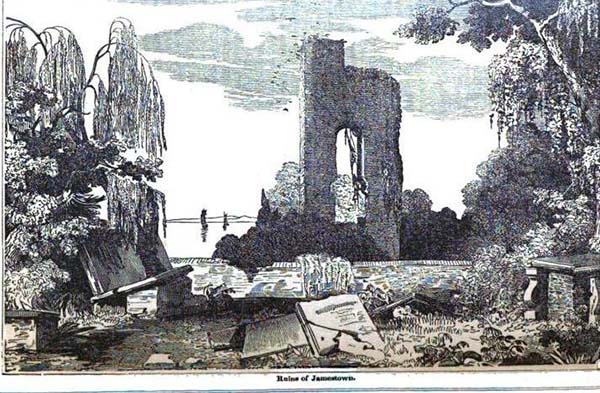
Joint-stock companies in England had tried numerous times to establish a colony in North America. It was no sure thing that Jamestown would be the first.
Jamestown was a settlement founded by the Virginia Company of London, a joint-stock company named for Elizabeth I – the “virgin queen” – that had been given a monopoly by King James I. They departed England in 1607 with three ships, stopping in the West Indies before proceeding on to the Chesapeake Bay. They first made their settlement on an island, but found it too swampy and soon moved up the river they named the James. Their goal was to find silver and gold as the Spanish had done.
Early Troubles
They constructed the settlement of Jamestown, but many of the 500 colonists were “gentlemen” who were unaccustomed to physical labor. On top of that they had arrived too late in the year to put in a crop. Many of the original colonists “went native,” joining with the indigenous peoples of the region in order to survive. About ten percent of them died in the first few months and up to half were dead the following spring. By the “starving time” of the winter of 1609-10 only about 60 colonists remained alive and living in Jamestown.
The military leader of the original group was Captain John Smith who had instituted martial law the second year to get the settlers to put in a crop., but suffered a wound to the knee and was forced to return to England. The 1610 remnant population actually abandoned Jamestown briefly but soon encountered relief ships coming from England with supplies and more settlers. Among the replacements were Polish artisans whose skills included glassblowing, the first product exported by English colonists.
Tobacco
On a pass through the West Indies on the way to Virginia, John Rolfe had acquired a few pounds of tobacco seed. Europeans had had adequate time to become addicted to tobacco since the early Spanish colonists had sent the dried leaves back from the New World. This demand proved to be the lifeblood of the new English colony and new lands for the crop were needed. Further colonial expansion into the Indian lands exacerbated the rather tense relations between the two groups.
In order to alleviate these tensions, arrangements were made between the leader of the Powhatan Confederacy, the Algonquian-speakers who lived in the region, and the English colonists. Wahunsenecawh, the leader of the Confederacy whom the colonists called Powhatan, had a daughter known to the colonists as Pocahontas. This daughter was married to John Rolfe in order to cement relations between the English and the Confederacy in the Chesapeake.
During this period, the colony continued to grow its tobacco economy. Labor was obtained through the importation of indentured servants, usually indigent young men from England who had no prospects in the Mother Country and were willing to sign themselves into servitude, usually for a period of between three and seven years. To attract Englishmen of some means who were able to outfit a tobacco plantation, the Virginia colonists created the Headright System. For every member of a gentry’s household, the Virginia Company promised 50 acres if he could afford to set up a plantation. In this way, the colony expanded further onto Indian lands.
1619: A Significant Year
By the year 1619, the colony was established enough to form a governing body. They formed the House of Burgesses for the purpose of self-governance in this country far from the organizing forces of King-in-Parliament. Also in this year, it was acknowledged in the Mother Country that the ratio of men to women in Virginia had reached 5:1. In response, a ship with a “cargo” of women was dispatched to Jamestown where they were sold for 120 pounds of tobacco each. Also in 1619, a Dutch slave ship sold over 20 African slaves at the dock, the first in English North America.
Conflict with Indians
Members of the Powhatan Confederacy, of which the main group were the Pawmunkeys, had saved the lives of the colonists in the early days. Since then, the John Rolfe – Pocahontas marriage had maintained an uneasy peace. Pocahontas, whose real name was Matoaka, had gone to England with Rolfe, where she was trussed up in English clothing and shown about the Court and aristocratic circles of London. During this trip she contracted an Old World disease and died in England at the age of 17. Her father, Wahunsenecawh, died soon afterward.
The leadership of the Confederacy fell then to Opechancanough, the brother of Wahunsenecawh. The new leader did not care for the English and wanted to see them driven into the sea. The expansion of the plantations and the dismissive way many of the English treated the Indians wore on Opechancanough and his followers. In 1622, the Indians attacked the outlying plantations and villages that had only recently been built. Several hundred English were killed and the remainder had to retreat to the garrison at Jamestown.
The English, however, were very good at warfare, and their counter-attack drove the Indians into the woods. The English sacked and burned their villages, killing many of the Confederacy and destroying their winter stores. In the broader view, this conflict began what has been called the “Indian Wars,” a centuries long conquest of North America by the English, their colonists, and subsequent generations of immigrants. King James I, fearful of losing control of the now-profitable Virginia Colony, declared it a Royal colony in 1624, thus ending the private venture. The colony grew as a part of the “plantation complex” of the British Empire, where staple crops were produced by slaves to create wealth for the planters.
Sources:
- Eric Foner, Give Me Liberty! (New York: Norton, 2010).
- James Henretta, et al., America: A Concise History (New York: Bedford St. Martin’s, 2008).







